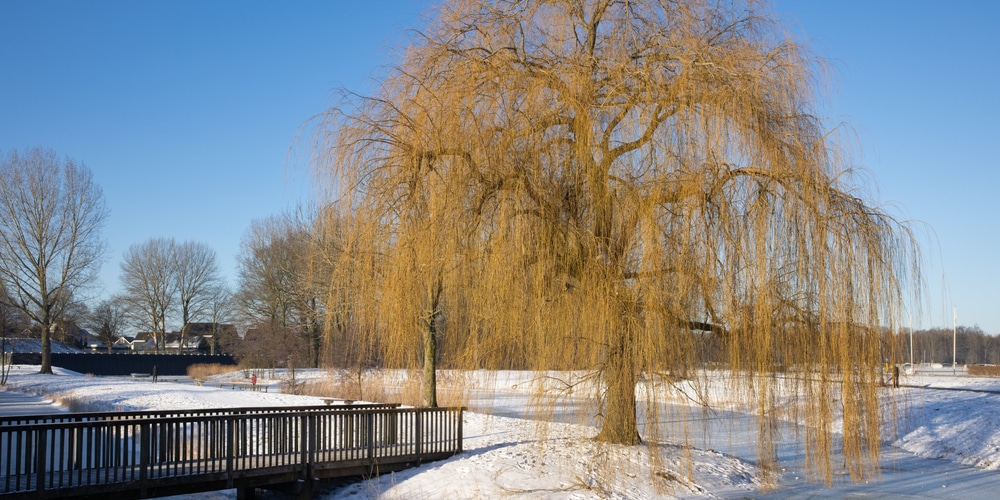Have you ever wondered what a Weeping Willow in winter looks like? The tree’s long tresses of foliage are a spectacular sight from spring through fall, but how does it fare in the cold season?
Let’s take a closer look at the weeping willow’s habits in winter and how the tree can survive the frost and plummeting temperatures.
What Do Weeping Willows Look Like in Winter?

The Weeping Willow is a deciduous tree variety and therefore has a habit of shedding its leaves come autumn or fall.
The tree sports long and glorious trailing leaves that appear bright green when spring comes around. The color turns dark as the growing season progresses, then transforms into a bright, look-at-me yellow before the leaves start falling to the ground.
In winter, all that’s left of a willow tree are its stems and branches which tend to collect snow (if there’s any). The tree retains its form, with the drooping branches turning white and making a spectacular landscape show.
It’s worth noting that weeping willows are among the first to herald the arrival of spring. They welcome the warmer weather by sprouting small and tender leaves in March or April. The tree also grows quickly and can have a height of 50 feet tall and a similar spread. Its lifespan is rated at an average of 30 years.
What Months Do Weeping Willow Trees Lose Their Leaves?
Weeping willows tend to shed their leaves from late fall until early or mid-winter. Willows can start losing leaves as early as July through September, then until November through winter.
The tree can drop leaves in July and during the summer months in warmer climates to retain as much water to survive. If weeping willows do not get enough water they will shed their foliage as a response. Drought and hot days can also produce the same effect.
Traditionally, weeping willows will change their leaves from green to yellow in September and through the winter season. They won’t lose their leaves in one go, as it happens gradually and over time.
The tree loses all its leaves in mid-winter until early spring and then bounces right back as long as it’s alive. It’s worth noting that weeping willows enter a dormant state in winter, which means they become inactive and stop growing for the rest of the season.
It’s not unusual for a weeping willow tree to start shedding leaves in mid- or late summer. When this happens, you should look at the soil around it and see if the tree is getting enough water. You can also check for the presence of pests or see if the tree is afflicted with a disease.
Can Weeping Willows Survive Winter?
Weeping willows are known to survive cold spells and can live through winter seasons in USDA zones 4 through 10.
The deciduous tree species enter a state of dormancy and shed their leaves to survive the winter seasons. During this time, watering should be reduced and no fertilizer should be given. You should also hold off on pruning until spring.
Those living in zones 3 and below may need to take some extra steps to overwinter their weeping willow trees. One way to ensure your tree survives the frost is to grow it in a container and bring it inside before the cold arrives. As a guideline, the lowest average temperature in a zone 4 region is minus 30 to minus 20 degrees F (or minus 28 degrees C).
Caring for a weeping willow in winter is minimal as the tree is in a dormant state. As long as you live in the recommended USDA growing zone (4 to 10) then you won’t have to do anything for your weeping willow to grow back the next season. Watering should only be done intermittently, and pruning is not recommended as it can bleed sap.
Weeping willow in winter: Final thoughts
Newly-planted weeping willows may not take to the cold too well, and for this reason, you may want to invest in a commercial-grade tree wrap you can put around the trunk to shield the tree from the winter sun.
As your weeping willow tree grows and enters its fourth and subsequent years it should be hardy enough to survive on its own.
Related Article: How Short Can You Cut a Weeping willow Tree
